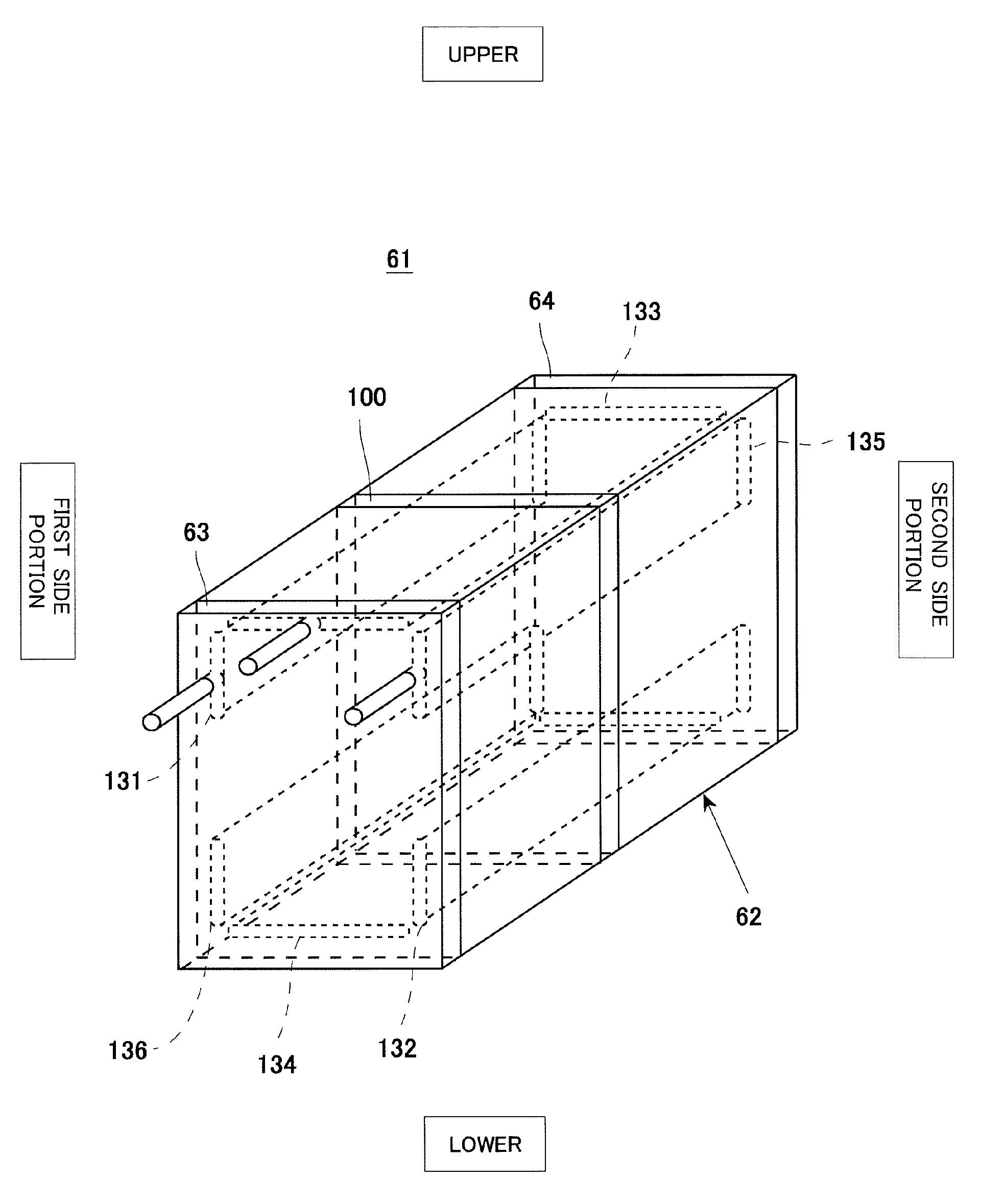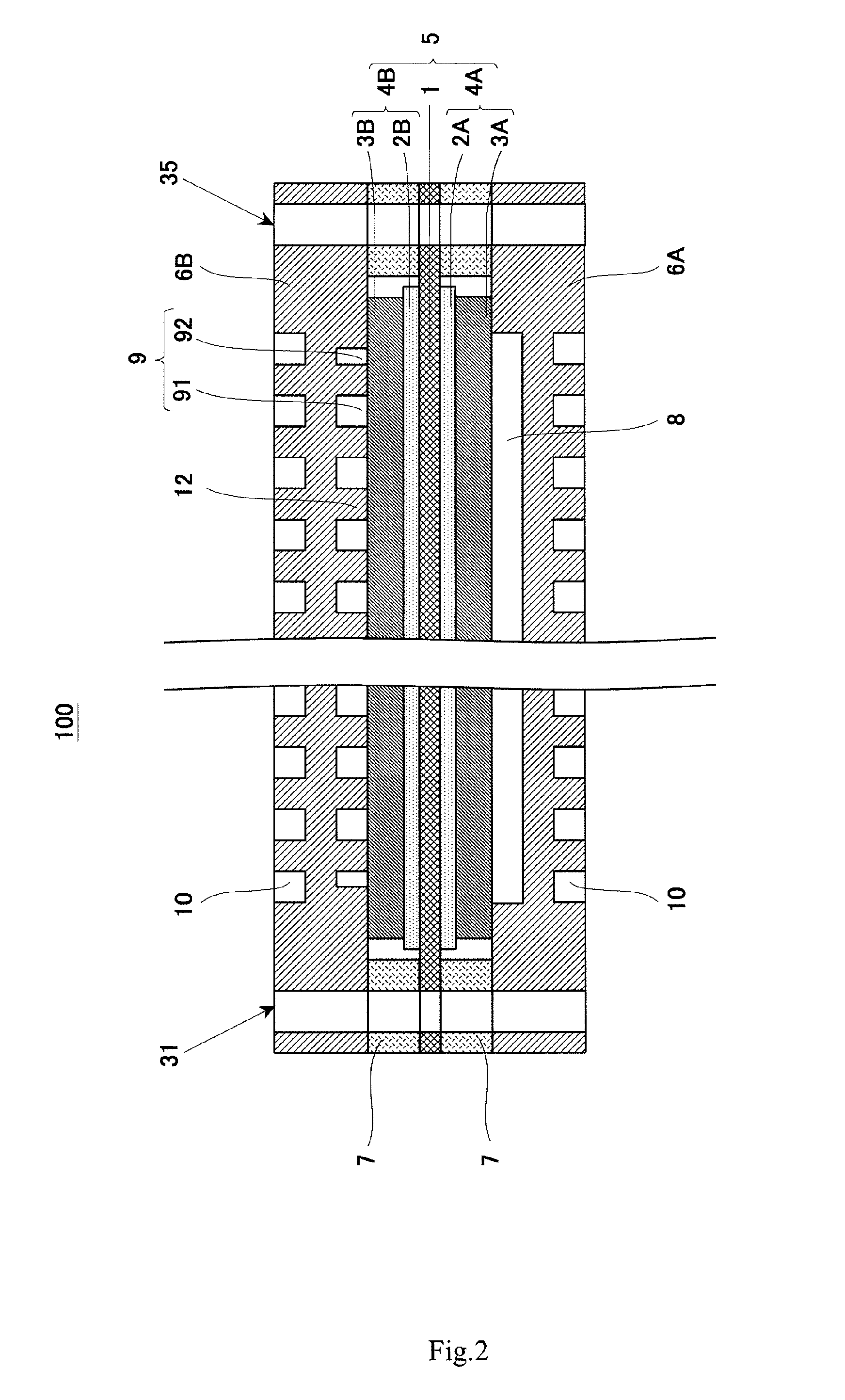Polymer electrolyte fuel cell
- Summary
- Abstract
- Description
- Claims
- Application Information
AI Technical Summary
Benefits of technology
Problems solved by technology
Method used
Image
Examples
embodiment 1
[0051]Configuration of Fuel Cell Stack
[0052]FIG. 1 is a perspective view schematically showing the schematic configuration of a fuel cell stack including a polymer electrolyte fuel cell (hereinafter simply referred to as a “fuel cell”) according to Embodiment 1 of the present invention. In FIG. 1, the upper-lower direction of the fuel cell stack is shown as the upper-lower direction of the drawing.
[0053]As shown in FIG. 1, a fuel cell stack 61 according to Embodiment 1 of the present invention includes a cell stack body 62, first and second end plates 63 and 64, and fastening members. The cell stack body 62 is formed by stacking fuel cells 100 in a thickness direction of the fuel cell 100. The entire shape of each fuel cell 100 is a plate shape. The first and second end plates 63 and 64 are respectively provided on both ends of the cell stack body 62. The fastening members fasten the cell stack body 62 and the first and second end plates 63 and 64 in a stack direction of the fuel ce...
embodiment 2
[0098]FIG. 5 is a cross-sectional view schematically showing the schematic configuration of the fuel cell according to Embodiment 2 of the present invention.
[0099]As shown in FIG. 5, the fuel cell 100 according to Embodiment 2 of the present invention is the same in basic configuration as the fuel cell 100 according to Embodiment 1 but is different from the fuel cell 100 according to Embodiment 1 in that the fuel cell 100 according to Embodiment 2 further includes reinforcing members 13. Specifically, each of the reinforcing members 13 is provided between the polymer electrolyte membrane 1 and the gasket 7 so as to be sandwiched therebetween.
[0100]The reinforcing member 13 is formed to have a substantially rectangular shape and a doughnut shape when viewed from the thickness direction of the cathode separator 6B. Moreover, the reinforcing member 13 is formed such that an inner peripheral end thereof is located on an inner side of the outer end of the anode catalyst layer 2A or the c...
embodiment 3
[0109]FIG. 7 is a cross-sectional view schematically showing the schematic configuration of the fuel cell according to Embodiment 3 of the present invention.
[0110]As shown in FIG. 7, the fuel cell 100 according to Embodiment 3 of the present invention is the same in basic configuration as the fuel cell 100 according to Embodiment 1 but is different from the fuel cell 100 according to Embodiment 1 regarding the configuration of the second oxidizing gas channel 92 of the oxidizing gas channel 9. Specifically, the second oxidizing gas channel 92 is formed such that the depth thereof is smaller than that of the first oxidizing gas channel 91. With this, the cross-sectional area of the second oxidizing gas channel 92 can be made smaller than that of the first oxidizing gas channel 91. To be specific, the flow rate of the oxidizing gas flowing through the second oxidizing gas channel 92 can be made lower than that of the oxidizing gas flowing through the first oxidizing gas channel 91.
[01...
PUM
 Login to View More
Login to View More Abstract
Description
Claims
Application Information
 Login to View More
Login to View More - R&D Engineer
- R&D Manager
- IP Professional
- Industry Leading Data Capabilities
- Powerful AI technology
- Patent DNA Extraction
Browse by: Latest US Patents, China's latest patents, Technical Efficacy Thesaurus, Application Domain, Technology Topic, Popular Technical Reports.
© 2024 PatSnap. All rights reserved.Legal|Privacy policy|Modern Slavery Act Transparency Statement|Sitemap|About US| Contact US: help@patsnap.com










